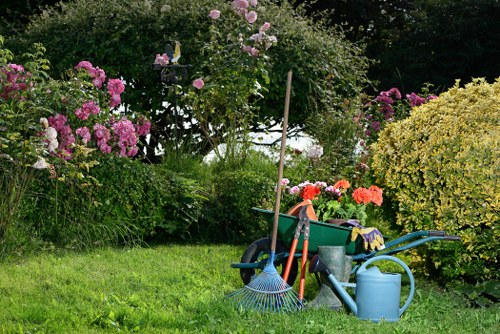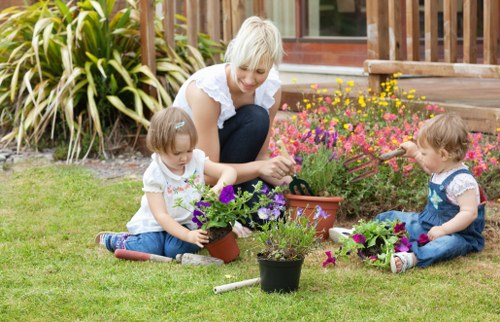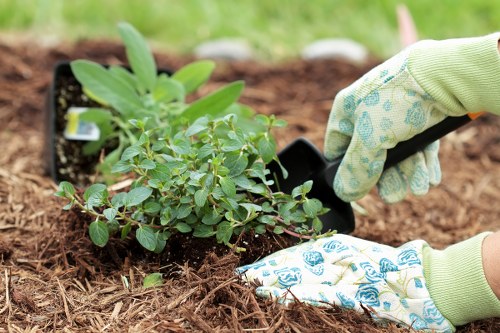Landscape Gardening in Kentish Town

Welcome to the vibrant world of landscape gardening in Kentish Town, where urban living meets lush greenery. Nestled in the heart of London, Kentish Town offers a unique blend of historical charm and modern convenience, making it an ideal location for garden enthusiasts to create stunning outdoor spaces.
Whether you're looking to transform a small balcony or a spacious backyard, landscape gardening in this area provides endless opportunities to enhance your living environment. With a variety of plants, design styles, and sustainable practices, you can tailor your garden to suit your personal taste and the local climate.
In this comprehensive guide, we'll explore the key elements of successful landscape gardening in Kentish Town, offering tips and insights to help you create and maintain a beautiful, functional garden year-round.
Why Choose Kentish Town for Your Garden

Kentish Town is renowned for its green spaces and community spirit, making it a perfect backdrop for landscape gardening. The area's rich history and diverse culture contribute to a dynamic gardening scene, where traditional and contemporary styles coexist harmoniously.
The climate in Kentish Town is relatively mild, with moderate rainfall and temperatures that support a wide range of plant species. This versatility allows gardeners to experiment with different flora, from vibrant perennials to elegant shrubs and trees.
Moreover, the presence of local nurseries and gardening centers provides easy access to quality plants and materials. The community often hosts gardening workshops and events, fostering a supportive environment for both novice and experienced gardeners.
Community and Support

The strong sense of community in Kentish Town means that gardening enthusiasts can easily share knowledge and resources. Joining local gardening clubs or online forums can provide valuable insights and inspiration for your projects.
Additionally, many residents take pride in their gardens, contributing to the area's overall aesthetic appeal. This collective effort not only enhances property values but also creates a welcoming atmosphere for visitors and neighbors alike.
Engaging with the local community can lead to collaborations and joint projects, such as community gardens or public green spaces, further enriching the landscape of Kentish Town.
Planning Your Landscape Garden

Effective planning is the cornerstone of any successful landscape garden. Start by assessing your available space, considering factors like sunlight, soil quality, and existing structures. Understanding these elements will help you make informed decisions about plant selection and garden layout.
Selecting the Right Plants is crucial for creating a sustainable and visually appealing garden. Opt for native species that thrive in the local climate and require minimal maintenance. Incorporating a mix of evergreen and deciduous plants can provide year-round interest and structure.
Designing with purpose involves determining the primary function of your garden. Whether you aim to create a relaxing retreat, a space for entertaining, or a habitat for wildlife, your design choices should align with these goals.
Assessing Your Space

Begin by mapping out the dimensions of your garden area. Note any existing features such as trees, fences, or paths that will influence your design. Consider how you use the space and what improvements would enhance its functionality and beauty.
Take into account the orientation of your garden. South-facing areas receive more sunlight, making them suitable for sun-loving plants, while north-facing sections may be better suited for shade-tolerant varieties.
Additionally, evaluate the soil type and drainage. Healthy soil is the foundation of a thriving garden, so testing and amending it as needed can significantly improve plant health and growth.
Selecting the Right Plants

Choosing the appropriate plants is essential for creating a harmonious and low-maintenance garden. Native plants are an excellent choice as they are well-adapted to the local environment and support local wildlife.
Perennials provide lasting beauty, returning year after year with minimal effort. Consider a mix of flowering and foliage perennials to ensure continuous interest throughout the seasons.
Incorporating shrubs and small trees can add structure and height to your garden, creating layers and depth. These larger plants also offer privacy and wind protection, enhancing the comfort of your outdoor space.
Designing with Purpose

Define the purpose of your garden to guide your design decisions. A well-planned garden serves multiple functions, whether it's providing a peaceful sanctuary, an area for social gatherings, or a space that attracts pollinators and wildlife.
Consider incorporating features such as seating areas, pathways, water elements, and lighting to enhance the functionality and ambiance of your garden. Each element should complement the overall design and contribute to the intended purpose.
Creating focal points, such as a specimen tree, a sculpture, or a water feature, can draw the eye and add visual interest to your landscape.
Sustainable Gardening Practices

Embracing sustainable gardening practices not only benefits the environment but also results in a healthier and more resilient garden. Implementing strategies like water conservation, soil health management, and promoting biodiversity can lead to long-term success.
Water conservation techniques, such as mulching and drip irrigation, reduce water waste and ensure that your plants receive adequate moisture without excess runoff. These practices are especially important in urban settings where water resources may be limited.
Maintaining soil health through composting and the use of organic fertilizers promotes strong plant growth and reduces the need for chemical inputs. Healthy soil supports beneficial microorganisms and improves overall plant resilience against pests and diseases.
Water Conservation

Incorporate water-efficient methods into your garden design to minimize water usage. Mulching around plants helps retain soil moisture and suppresses weeds, reducing the need for frequent watering.
Installing a rainwater harvesting system can capture and store rainwater for garden use, providing an eco-friendly water source. Additionally, choosing drought-resistant plants can significantly lower your garden's water demands.
Implementing a drip irrigation system delivers water directly to the plant roots, ensuring efficient usage and minimizing evaporation. This targeted approach not only conserves water but also promotes healthier plant growth.
Soil Health

Healthy soil is the foundation of a thriving garden. Regularly amend your soil with organic matter, such as compost or well-rotted manure, to enhance its structure and fertility.
Planting cover crops during the off-season can prevent soil erosion, improve nutrient content, and encourage beneficial soil organisms. Additionally, practicing crop rotation and avoiding monoculture can reduce the risk of soil-borne diseases.
Testing your soil periodically allows you to monitor pH levels and nutrient availability, enabling you to make informed decisions about fertilization and plant selection.
Biodiversity

Promoting biodiversity in your garden supports a healthy ecosystem and enhances resilience against pests and diseases. Incorporate a variety of plant species to provide habitat and food sources for beneficial insects, birds, and other wildlife.
Creating diverse plant layers, from groundcovers to tall shrubs and trees, adds complexity and encourages interactions among different organisms. Additionally, avoiding pesticides and herbicides maintains the natural balance of your garden ecosystem.
Including native flowering plants attracts pollinators, which are essential for plant reproduction and overall garden health. By fostering a biodiverse environment, your garden becomes a vibrant and dynamic space.
Seasonal Maintenance Tips

Maintaining your landscape garden throughout the year ensures its ongoing beauty and health. Each season presents unique challenges and opportunities for garden care, requiring specific attention to keep your outdoor space thriving.
Spring is a time of renewal, ideal for planting new flowers and preparing the soil for the growing season. Pruning dead branches and fertilizing plants can promote healthy growth and vibrant blooms.
In the summer, regular watering and mulching help your plants withstand the heat. Pruning and deadheading encourage continuous flowering, while pest control measures protect against common garden threats.
Spring Preparations

As the weather warms, prepare your garden by clearing out winter debris and enriching the soil with compost or organic fertilizers. Planting early-spring bulbs and perennials ensures a colorful display as temperatures rise.
Pruning flowering shrubs and trees encourages new growth and maintains their shape. It's also an ideal time to install new garden features, such as patios or raised beds, to enhance your garden's functionality and appeal.
Implementing a regular maintenance schedule in spring sets the foundation for a successful growing season, ensuring that your plants receive the care they need to thrive.
Summer Care

During the summer months, prioritize watering and mulching to maintain soil moisture and reduce evaporation. Installing shade structures or selecting heat-tolerant plants can help your garden withstand the intense summer heat.
Regularly inspect your garden for signs of pests and diseases, taking prompt action to address any issues. Encouraging natural predators, such as ladybugs and birds, can help control pest populations naturally.
Pruning and deadheading spent flowers not only keeps your garden looking tidy but also promotes continuous blooming. Additionally, harvesting vegetables and herbs at their peak ensures the best flavor and encourages further production.
Autumn Cleanup

Autumn is the perfect time to prepare your garden for the colder months. Removing fallen leaves and spent plants prevents the buildup of pests and diseases, maintaining a healthy garden environment.
Planting autumn-blooming flowers and shrubs adds color and interest during the transitional season. Dividing perennials and planting them in new locations encourages vigorous growth in the following spring.
Protecting tender plants with mulch or frost covers shields them from early frosts and harsh weather, ensuring their survival through the winter months.
Winter Protection

Winter can be harsh on your landscape garden, but with proper care, your plants can withstand the cold months. Mulching around the base of plants helps insulate the soil, retaining moisture and regulating temperature fluctuations.
Pruning hardy shrubs and trees during the dormant season promotes healthy growth in the spring. Additionally, wrapping delicate branches and stems with burlap or protective covers prevents frost damage and breakage from heavy snow or ice.
Utilizing evergreen plants and winter-hardy varieties ensures that your garden remains visually appealing even during the colder months, providing structure and interest when other plants may be dormant.
Hiring Professional Landscape Gardeners in Kentish Town

While DIY gardening can be rewarding, hiring professional landscape gardeners in Kentish Town offers numerous benefits. Professionals bring expertise, experience, and a keen eye for design, ensuring that your garden achieves its full potential.
When selecting a landscape gardener, look for qualifications, portfolio examples, and client testimonials to gauge their capability and style. A good professional will work closely with you to understand your vision and translate it into a cohesive garden design.
Professional services can range from initial planning and design to ongoing maintenance and seasonal care, providing comprehensive support to keep your garden thriving year-round.
What to Look For

Choose a landscape gardener with a solid reputation and a portfolio that aligns with your aesthetic preferences. Clear communication and transparency in pricing are also essential factors to consider.
Ensure that the gardener is knowledgeable about local plant species and sustainable practices, as this will contribute to the long-term health and resilience of your garden.
Discuss your goals and expectations upfront to ensure that the professional can deliver the results you desire, working within your budget and timeline.
Benefits of Professional Services

Engaging a professional landscape gardener saves time and effort, allowing you to enjoy your garden without the stress of maintenance. Professionals can identify and address potential issues before they become major problems, ensuring the longevity of your garden.
They also bring creative solutions and innovative design ideas that can elevate your garden's aesthetic and functionality, making it a true reflection of your personal style.
Additionally, professional gardeners have access to high-quality materials and tools, enhancing the overall quality and durability of your garden features.
DIY vs Professional Landscaping

Deciding between DIY landscaping and hiring a professional depends on your skills, time availability, and the complexity of the project. DIY gardening offers personal satisfaction and cost savings, allowing you to customize your garden at your own pace.
However, complex projects may benefit from professional expertise, ensuring precision and high-quality results. Professionals can also offer guidance on plant selection, design principles, and maintenance practices that may be challenging for a DIY enthusiast.
Ultimately, the choice between DIY and professional landscaping should consider your personal preferences, budget, and the desired outcome for your garden.
Trends in Kentish Town Landscaping

Staying updated with the latest trends in Kentish Town landscaping can inspire fresh ideas and enhance your garden's appeal. Current trends emphasize sustainability, minimalism, and the integration of technology to create modern, functional outdoor spaces.
One popular trend is the incorporation of modern minimalist gardens, characterized by clean lines, simple plantings, and uncluttered spaces. This style focuses on creating a serene and orderly environment, ideal for relaxation and contemplation.
Traditional English gardens also remain a favorite, offering timeless beauty with a mix of colorful blooms, well-manicured lawns, and classic garden structures like pergolas and trellises.
Modern Minimalist Gardens

Modern minimalist gardens prioritize simplicity and functionality, using architectural elements and a restrained color palette to create a sophisticated look. Key features include geometric planting beds, ornamental grasses, and strategically placed sculptures or water features.
These gardens often incorporate sustainable practices, such as using native plants and organic materials, to minimize environmental impact and reduce maintenance requirements.
The minimalist approach promotes a sense of calm and order, making it an excellent choice for urban gardens where space and resources may be limited.
Traditional English Gardens

Traditional English gardens are celebrated for their classic elegance and rich biodiversity. They typically feature a variety of flowering plants, perennials, and shrubs arranged in picturesque patterns and borders.
Key elements include herbaceous borders, romantic pathways, and ornamental structures such as gazebos and birdbaths. These gardens often incorporate climbing plants and roses, adding layers of texture and color.
The emphasis on perennial blooms ensures that the garden remains vibrant across multiple seasons, providing continuous visual interest and attracting pollinators.
Eco-friendly Designs

Eco-friendly landscaping focuses on sustainable practices that benefit both the environment and the garden's health. This includes using native plants, implementing efficient irrigation systems, and reducing chemical use.
Designs may incorporate rain gardens, green roofs, and natural materials to create a harmonious balance between the built environment and nature. These practices not only enhance the garden's sustainability but also contribute to urban biodiversity.
By embracing eco-friendly designs, gardeners in Kentish Town can create beautiful, resilient landscapes that support local ecosystems and promote environmental stewardship.
Conclusion

Landscape gardening in Kentish Town offers a unique opportunity to blend urban living with the tranquility of nature. By thoughtfully planning your garden, embracing sustainable practices, and staying informed about the latest trends, you can create a beautiful and functional outdoor space that enhances your quality of life.
Whether you choose to embark on this journey yourself or enlist the help of professional landscape gardeners, the rewards of a well-maintained garden are well worth the effort.
Contact us today to start transforming your garden dreams into reality, or book your service now and take the first step towards a stunning landscape that you can enjoy for years to come.